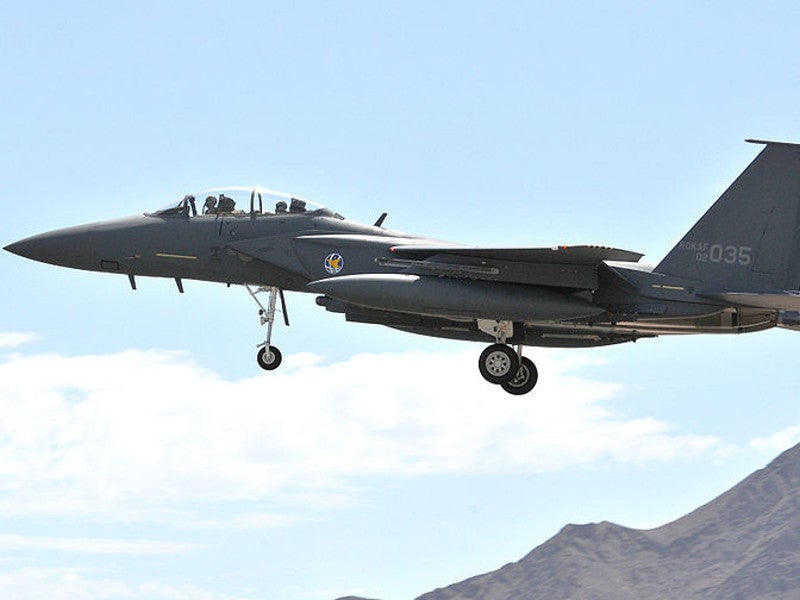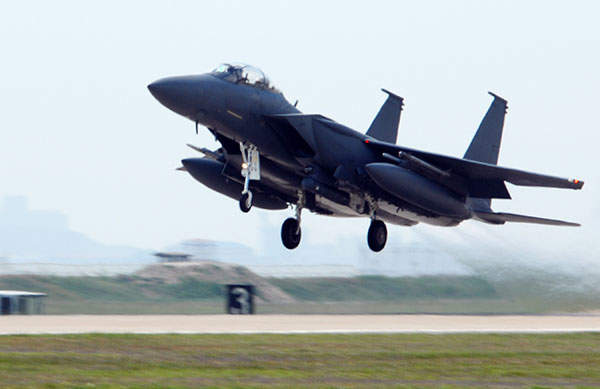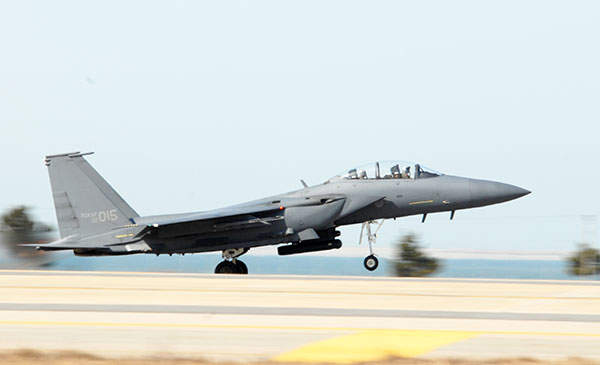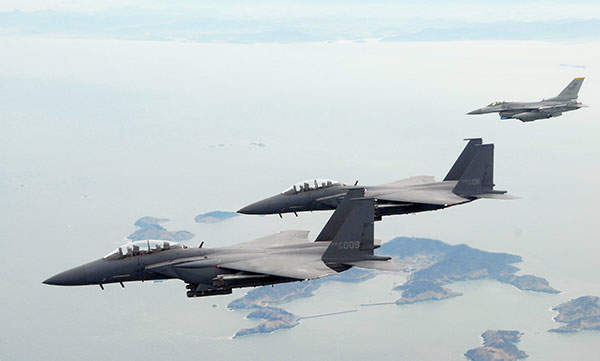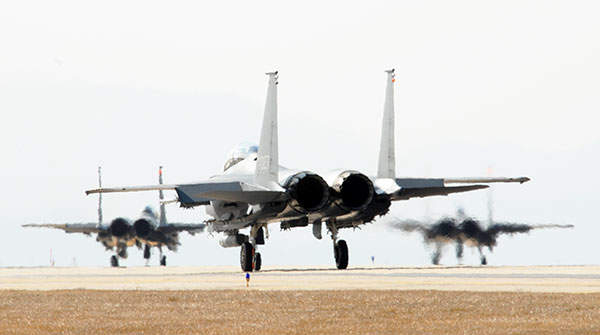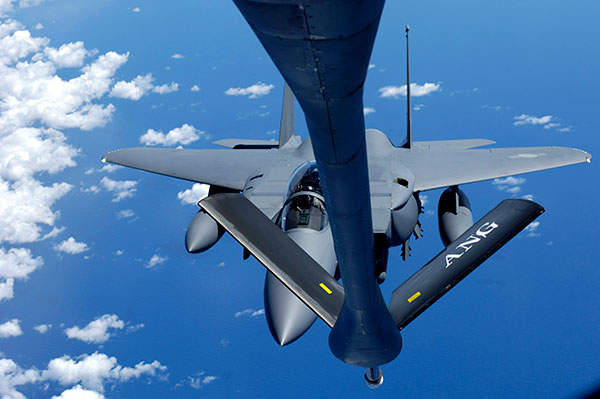The F-15K Slam Eagle is a multi-role fighter aircraft manufactured by Boeing for the Republic of Korea Air Force (ROKAF). It is an advanced variant of the F-15E Strike Eagle fighter. It can conduct long-range precision strike missions during day or night, in all weather conditions.
F-15K is equipped with state-of-the-art mission equipment to conduct air-to-ground, air-to-air, and air-to-sea missions.
The ROKAF selected the F-15K Slam Eagle for its Next Generation Fighter Programme in April 2002. The aircraft made its first flight in March 2005. The first aircraft was rolled out from the Boeing site in St Louis the same month.
The service life of the current F-15K fleet is expected to last until 2040 and beyond.
F-15K orders and deliveries
ROKAF placed a $4.2bn contract with Boeing for 40 F-15K Slam Eagle fighter jets, in June 2002. The first two F-15Ks were delivered to Korea at the Seoul Air Show in October 2005. The 40th ROKAF F-15K aircraft was delivered during the Red Flag exercise at Nellis Air Force Base in August 2008. All deliveries under the contract were officially concluded in October 2008.
In April 2008, Boeing received a contract to deliver 21 F-15K aircraft to ROKAF under Next Fighter II programme. Boeing delivered the first six of 21 F-15Ks in 2010. Two more aircraft were delivered in April 2011. The ninth and tenth ROKAF F-15K aircraft were delivered in June 2011. All the deliveries were concluded with the handover of final two aircraft to the ROKAF at Daegu Air Base in April 2012.
Cockpit
The glass cockpit of the F-15K accommodates two crew members including a pilot and a weapon systems officer (WSO). The cockpit display suite from Kaiser Electronics integrates three flat panel colour displays, four multi-purpose displays, two upfront control panels, a wide field of view head-up display (HUD), and a joint helmet mounted cueing system (JHMCS).
Weapon systems
The F-15K Slam Eagle accommodates a wide range of weapons and a payload of over 13,000kg for achieving multi-role strike capability.
The aircraft can carry a combination of air-to-air weapons including a 20mm cannon, AIM-9 Sidewinder infrared-guided air-to-air missiles, Raytheon AIM-7 Sparrow radar-guided air-to-air missiles, AIM-120 advanced medium-range air-to-air missile (AMRAAM), and AGM-130 missile.
AIM-9 Sidewinder has a range of 8km, while the range of Sparrow is 45km. The AMRAAM can strike aerial targets within the range of 55km.
The air-to-ground weapon systems aboard the F-15 include precision-guided munitions such as AGM-84D Harpoon anti-ship missiles and AGM-84E SLAM-Expanded Response (ER) air-to-ground missiles.
Targeting and countermeasures
The AN/APG-63 (V)1 Active Electronically Scanned Array (AESA) radar fitted to the F-15K is equipped with air-to-air and air-to-ground capabilities. The radar can track high-flying and low-flying targets, ground moving targets and sea surface targets. It provides high-resolution ground maps for identifying targets at long ranges.
F-15K uses Link-16 Fighter Data Link to distribute target information to other aircraft during coordinated air-to-air missions. The onboard Hands-on Throttle and Stick (HOTAS) controls allow the crew to operate weaponry, radars, avionics and other mission equipment. The aircraft is equipped with late-generation targeting and navigation systems such as forward-looking infrared (FLIR) and infrared search and track (IRST).
The integrated Tactical Electronic Warfare Suite (TEWS) integrates ALR-56C(V)1 early warning receiver, ALQ-135M jammer and ALE-47 Countermeasure Dispenser System (CMDS). The CMDS can launch conventional chaff and flare decoys to deceive anti-aircraft threats.
Engines and performance
The first 40 F-15K fighters are powered by two GE F110 turbofan engines, each developing 29,000lb of thrust per engine. The aircraft procured under Next Fighter II programme are equipped with two Pratt & Whitney F-100-PW-229 EEP engines. Each engine provides a thrust of 29,100lb.
The F-15K Slam Eagle can fly at a maximum speed of Mach 2.5. The combat radius or endurance of the aircraft is more than 1,800km. The aircraft can perform terrain-following flight at a minimum altitude of 100ft with a speed of Mach 0.93. It has a maximum gross take-off weight of 36,740kg.
Contractors involved
Korea Aerospace Industries (KAI) was contracted to supply aircraft components, including wings and forward fuselages for 32 to 40 F-15K aircraft of the Republic of Korea Air Force.
The GPS inertial navigation systems aboard the F-15K aircraft were developed by Doosan DST. Hanwha Corporation supplied hydraulic and flight control actuators, while Huneed Technologies provided wire harnesses.
LIG Nex 1 provided networking and avionics technology and Samsung Thales supplied electronic systems as well as radar warning receiving components. Landing gear components were supplied by WIA.
Boeing is responsible for the long-term and affordable performance-based logistics of the ROKAF F-15K aircraft fleet since 2012. The company secured a five-year performance-based logistics contract to continue the sustainment of the fleet in March 2017.
Boeing partnered with Hyundai Glovis to handle logistics and supply chain distribution in the country.

